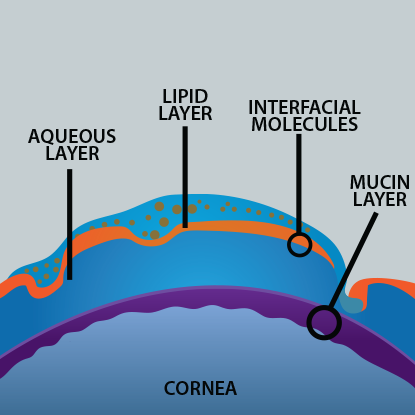




Dry eye is a common chronic medical condition that can have a significant effect on a patient's lifestyle and quality of life. It occurs when the eye's tear film is no longer able to lubricate and protect the surface of the eye. It is often the result of abnormalities in the quantity or the quality of the tear film.
The tear film is actually made up of three different layers. The outermost layer is an oily layer produced by the meibomian glands on the edge of the eyelids. The purpose of the oil layer is to smooth the tear surface, and to slow the evaporation of the tear film. The middle water layer is the largest layer. It is produced by glands located in the conjunctiva, and by the lacrimal gland. The innermost layer of the tear film is a mucus layer that makes the corneal surface more adherent for the water layer.
Dry eye can be a result of the normal aging process, but it can also be associated with a number of other conditions. It can be caused by eye surgery (especially LASIK), high altitudes, air travel, exposure to sun, wind, cold, contact lens wear and prolonged computer use. There are also a number of medical conditions that are very commonly associated with dry eye. These include thyroid disease, blepharitis, rheumatoid arthritis, lupus, Sjogren's syndrome, dietary deficiency of omega 3 essential fatty acids and menopause. In fact it is estimated that about 70% of menopausal and peri-menopausal woman suffer from dry eyes, most of which don't associate the condition with their menopause.
As well, there are a number of medications that can cause a dry eye. Antihistamines, diuretics, hormone replacement therapy, oral contraceptives, blood pressure medications and beta-blockers can all cause or exacerbate dry eyes.
There are a myriad of symptoms associated with dry eyes. The most common symptoms include excess tearing, burning, itching, redness, blurred vision that clears with blinking, and a foreign body sensation. The severity of the condition can range from mild to severe. In more severe cases the condition can be quite painful.
Taking a careful history and performing a thorough ocular examination make the diagnosis of dry eye. A variety of in-office tests are used to help confirm the diagnosis and determine the severity of the disease. These tests include Schirmer's testing, tear film break up time, dye staining of the ocular surface, and the use of the Ocular Surface Disease Index.
The treatment of dry eyes has to be tailored to the individual patient. In milder cases the use of over the counter artificial tears, environmental modification, allergy control, and nutritional support such as flaxseed or fish oil supplements, often controls the condition.
For patients with more severe disease the treatment is more complex. Switching to preservative free artificial tears, the nighttime use of topical gels, and prescription eye drops such as restasis and topical steroids all help control more advance disease. As well, the addition of punctual plugs once the inflammatory component of the disease is under control often enhances the effect of the other treatment modalities.